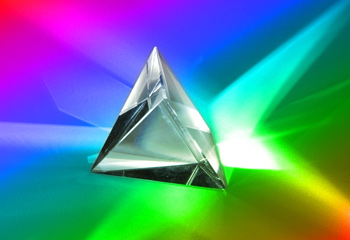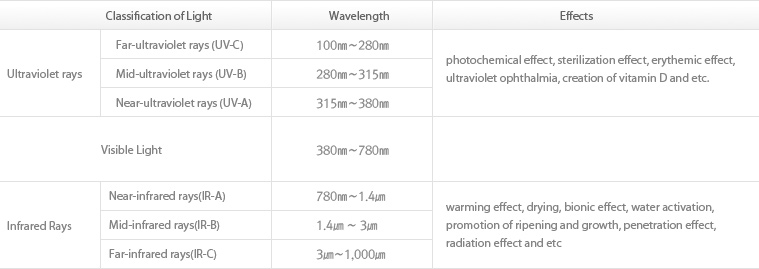Home | Contact Us | Chinese | Korean


The advantages of our products
Spec
WHAT IS INFRARED RAY?
● The physical meaning of the light
 The light which affects human life closely is a kind of energy which is formed as electromagnetic wave and particles. And infrared rays which have longer wavelength and ultraviolet rays which have shorter wavelength as well as the visible light are included in the energy emitted from the natural light and artificial light source. Light is physically one part of energy delivered as a form of electromagnetic wave or particles. But it is a sense to be perceived to the brain, changed into physiological energy by the human eyes.
The light which affects human life closely is a kind of energy which is formed as electromagnetic wave and particles. And infrared rays which have longer wavelength and ultraviolet rays which have shorter wavelength as well as the visible light are included in the energy emitted from the natural light and artificial light source. Light is physically one part of energy delivered as a form of electromagnetic wave or particles. But it is a sense to be perceived to the brain, changed into physiological energy by the human eyes.
The process of energy transfer or emission as a form of electromagnetic wave or particles is called radiation. Especially, energy radiation is called optical radiation, and heat energy radiation thermal radiation. There are three ways of heat energy transfer, convection, conduction and radiation. Infrared rays transfer heat energy through radiation. The wavelength of infrared rays radiated from the human body is 3㎛∼50㎛, which is the range of the far infrared rays. Among these, the far infrared rays of 8㎛∼14㎛ wavelength occupy 46% of the total radiation energy from the human body. Human body is a kind of natural heat source of average temperature, 36.5℃, that is, a natural biological source of infrared ray.
● Kinds of Light
Wavelength of light consists of different lights of different wavelengths. This wavelength of light is from the shortest one of one millionth㎛ to the long one of a few meters, and is classified as bellows according to the wavelength.

The visible light which causes the sense of light is an electromagnetic wave of 380㎚∼780㎚ wavelength range. And in the optical science, the colors are classified according to the wavelength range. With the visible light as the center, ultraviolet rays and infrared rays exist in the left and right respectively. Ultraviolet rays which have shorter wavelength than visible light's wavelength of 380㎚ has sterilization effect and photochemistry effect which causes fading and discoloration. It is classified to 3 ranges.
Infrared rays became known to us by the British astronomer, F.W. Herschel, who is from Germany in 1800. Herschel measured temperature of colors separated from the spectrum, and found out by chance that the temperature in the invisible light area increased. This was the first experiment to find out that the heat was transferred as a form of invisible light. The infrared rays of longer wavelength than 780㎚ and shorter than microwave do not produce sense of light at the eyes, but have the effect of heating. So it can dry or heat things.

● Effect of Infrared Rays
The temperature range we face in a daily life is 280℃∼-20℃ in general. If we calculate the radiation wavelength with Wien's displacement law, they are integrated into the far-infrared wavelength range of 5.2㎛∼11.5㎛. The far-infrared rays of 3㎛∼30㎛ wavelength are only commercially applied currently, and they have no chemical effect, but have physical and biological effects. The physical effects of infrared rays are radiation effect, resonance absorption effect, penetration effect, and the biological effects are expansion of micro-vessel of the organisms like human and animals, reinforcement of metabolism. The major effects of the far-infrared rays are generally known as bellows.
01. Bionic Effect and Nasty Smell Removing Effect
Body is mostly composed of water and protein, and among these, about 75% is water. When the vibration wavelength range of molecular motion of organic compound which composes water or protein is same as the wavelength of the irradiated far-infrared rays, body becomes activated. The absorption spectrum of organic compound is integrated in the wavelength of 6㎛∼14㎛. Far-infrared rays are absorbed and penetrated into the body by its unique penetration capability, make self-heating and bring warming and perspiration effects. With these effects, it improves regeneration capability of body tissues, promotes growth and makes vital health condition through its effects of expanding the micro-vessel, activating the tissues, promoting metabolism and discharging the bodily waste and harmful metals. In addition, far-infrared rays remove nasty smell by neutralizing the positive ion which is the main cause of the nasty smell because they can transform the air into the negativeion.
02. Activation of Water
Water is a cluster which is the group of molecules in which 5~12 H2O are connected in total form. When this group of molecules of water is stimulated by the far-infrared rays, ultrasonic waves and magnetic field from outside, the group of molecules of water becomes less and activated due to the activation of water molecules motion by resonance absorption effect.
If the far-infrared rays of about 10㎛ which is the vibration wavelength of water molecules are irradiated to the water, the cluster which is the molecules group of water becomes less and water molecules motion become fast due to the resonance absorption effect. The water becomes tasty through this process.
03. Ripening and Promotion of Growth
Ripening means the status having a special flavor through the decomposition of protein, fat and carbohydrate without rot by the effect of enzyme and microorganism. Irradiation of far-infrared rays makes multiplication of bacillus active and activates the bacillus itself in the vinegar. In addition, enzyme and lactobacillus are matured through various enzymatic reactions in the soy bean sauce. Like these, far-infrared rays promote ripening due to the increased hydration ability by activating the water. For example, it takes 2 months to mature the fruit wine in the natural condition, but takes only 1 day by irradiating far-infrared rays.
The water activated by the far-infrared rays promotes the growth of plant. The vibration of water molecules becomes high, friction occurs, cohesion of water becomes strong and the water rises. When the metabolism becomes activated by the capillary phenomenon, the roots suck up liquefied fertilizer to promote the growth. It makes the growth of flowers fast and makes flowers last long.
04. Economic Effect
Far-infrared rays have strong penetration ability. They penetrate deep into the substances, make heat by themselves and heat the inside evenly. So they can heat paint, food and body effectively, and thus, the heating by far-infrared rays is more economical than the heating by gas and others. Especially, they promote appetite increase and growth and reinforce the immunity in raising animals like pigs. In addition, they keep the farms clean and sanitary by drying straws. They increase the economic feasibility by reducing the loss in the raising because the piglets do not gather together due to the lack of heat.
9-7, Hwangsaeul-ro 200beon-gil, Bundang-gu, Seongnam-si, Gyeonggi-do 13595, KOREA
Copyright 2010 © by InterHeat CO., LTD. All right reserved.